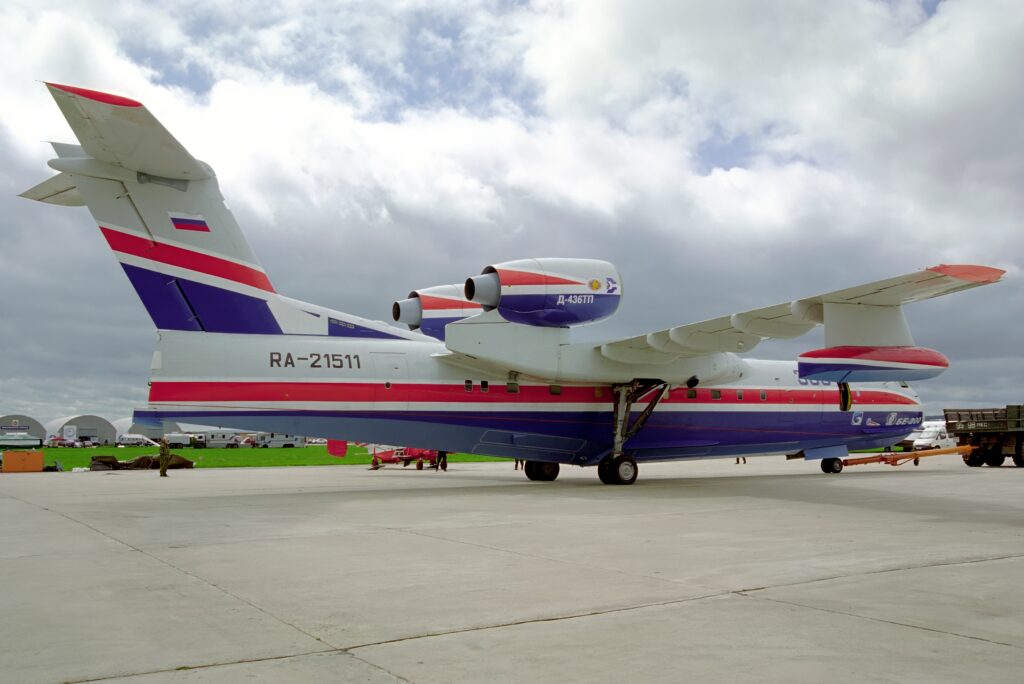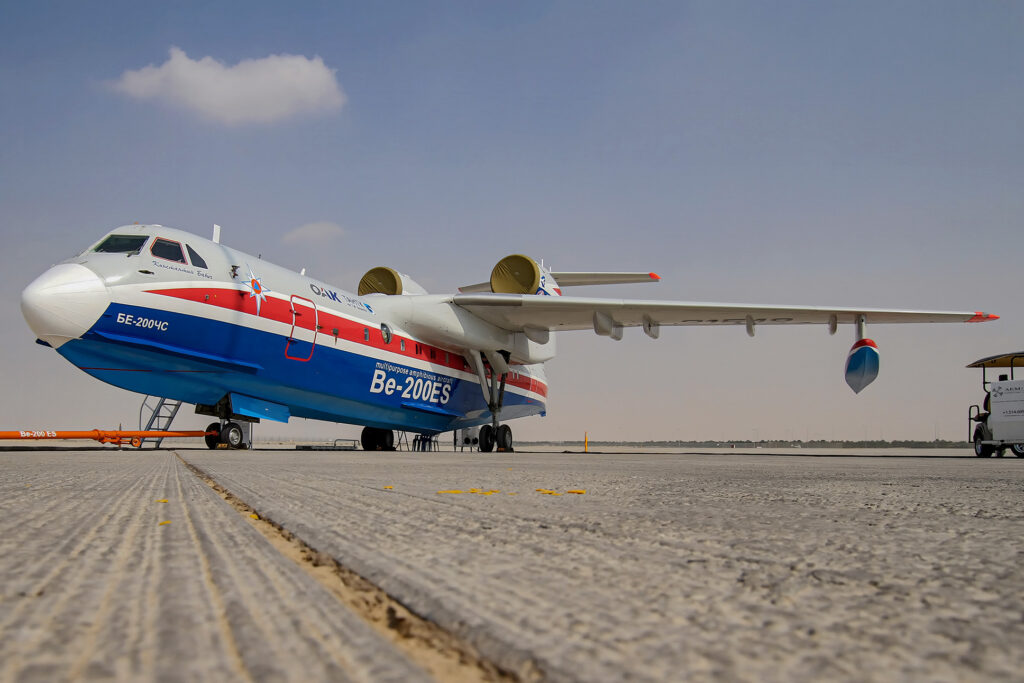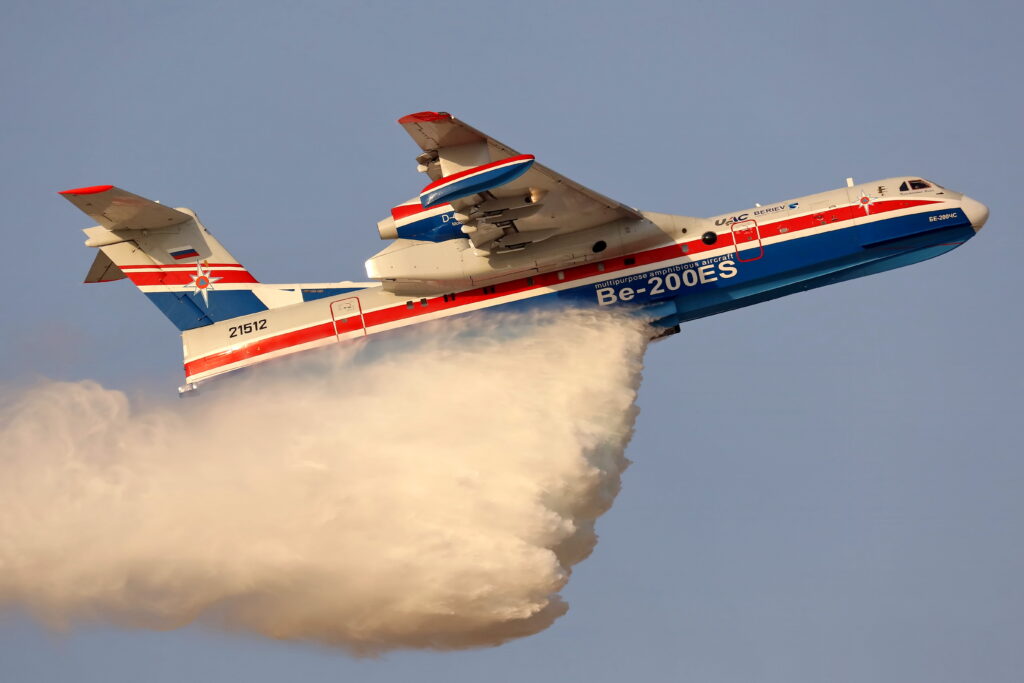The Russian-made Beriev Be-200ChS is the world’s only jet-engined Multirole amphibious aircraft, possessing the highest cruise speed and the highest water/fire-retardant capacity when compared to other amphibious fire-fighting aircraft currently operational around the world. Ukrainian-made Progress D-436TP turbofan engines power the Be-200ChS. The engine, which was once a strong point of the aircraft, quickly became its weakness, as in 2014, the Ukrainian manufacturer of the engine stopped supplying them to the Taganrog Beriev Plant, resulting in delays in production of nine Be-200s between 2020 and 2023 and suspending production of the remaining aircraft after drone strike on March 9, 2024.
Deterioration of the Russia-Ukraine relationship not only plagued the production of the aircraft at the Taganrog Beriev Plant but also caused spare part shortages for the 14 aircraft currently in use by the Russian Ministry of Emergency Situations (EMERCOM) and Russian Navy Aviation (VMF). This resulted in the availability of only nine airworthy Be-200s. The Beriev Taganrog Aviation Scientific-Technical Complex, the current manufacturer of the aircraft, began the Be-200 re-engining program to equip the aircraft with Russian Aviadvigatel PD-8 turbofan engines to date; no Be-200 has yet been manufactured with these engines.

In service of the EMERCOM
EMERCOM, or MChS Rossii, was established on January 10, 1994, following a plan dating back to December 27, 1990, when the Russian Soviet Federative Socialist Republic (RSFSR) established the Russian Rescue Corps and assigned it the mission of rapid response to emergencies. EMERCOM was equipped with a Central Air-Mobile Rescue Team to operate several search and rescue, firefighting, and cargo aircraft and helicopters for medical evacuation and firefighting missions. It subsequently became the predecessor of Aeroflot in performing aerial firefighting in Russia. It thus became the main customer of Be-200ChS, a variant of Be-200 designed especially to meet its needs for both firefighting and search and rescue operations.
In 2001, EMERCOM ordered seven Be-200ChS, with deliveries commencing in 2005. On December 29, 2003, the Russian Aviation Authority issued an AP-25 certificate for the Be-200ChS, equivalent to the American FAR-25 and European JAR-25 certificates. The first pre-serial produced Be-200ChS ordered by the EMERCOM was completed and flown on June 17, 2003. After completion of its tests, the aircraft, ‘RA-21515’ was delivered to EMERCOM on November 24, 2003, and received the ‘RF-21515’ registration code (later becoming RF-32765). Before its delivery to EMERCOM, TANTK demonstrated the aircraft in Sardinia, Italy, in July and August 2003 and then in Greece and France in October 2003.
Between May 2004 and October 2011, EMERCOM received six more Be-200ChS, except one with r/c RF-32766, manufactured at the IAPO plant. In addition to the six IAPO-built Be-200ChS of EMERCOM, a seventh aircraft, RF-32769, which had been first flown in June 2007, was built at IAPO for EMERCOM but was later sold and delivered to the Azerbaijan Ministry of Emergency Situations on April 30, 2008. Earlier in 2006, decisions were made to manufacture the remaining Be-200s on order at the TANTK plant at Taganrog to free up production lines of IAPO for manufacturing Su-30MKI fighter jets for India. As a result of that, the production of the fifth Be-200ChS ordered by EMERCOM took place at Taganrog. The aircraft was delivered to EMERCOM on January 12, 2007.

While the first and second Be-200ChS of EMERCOM were based in Moscow-Zhukovsky and Khabrovcsk, respectively, the third aircraft, ‘RF-32517’ (later RF-32767), was based in Krasnoyarsk in 2006. The fourth aircraft, RF-32768 (now RF-32770), was based in Moscow-Zhukovsky airport after its delivery on September 29, 2006. On January 30 and October 21, 2011, EMERCOM received the two last Be-220ChS built at Irkutsk. They were RF-31121 and RF-31130.
In 2010, EMERCOM ordered more Be-200ChS aircraft, increasing the total number planned for its use by 2016 to 12. On May 25, 2011, EMERCOM ordered six more Be-200ChS, with deliveries set for 2013 and 2014. These aircraft were going to be manufactured at Taganrog alongside two Be-200ChS-E (export version) ordered by the Algerian Air Force and one Be-200ChS and two Be-200PS (SAR variant) ordered by the Russian Navy.
Deterioration of the Russia-Ukraine relationship due to the annexation of Crimea and subsequent plans of Russia for the dissolution of Ukraine using separating Donetsk and Luhansk Oblasts led to delays in deliveries of additional D-436TP engines for the aircraft in production at the TANTK plant. Finally, after several years of delays, the plant completed five out of six additional Be-200ChS orders by EMERCOM.

The five Be-200ChS with RF-31120, RF-31140, RF-31380, RF-32768, and RF-31390 registration codes were delivered to the EMERCOM on 23 July 2017, 20 December 2017, 31 March 2018, 7 September 2018, and 27 February 2019, respectively. With several years of delay, the Russian Navy Aviation received its three aircraft, a Be-200ES (ChS), RF-88450 on 14 August 2021 and two Be-200PS, RF-88456 and RF-88457, in January and September 2021, respectively. The last aircraft was the Be-200ChS-E ordered by Algeria for the Algerian Air Force, delivered in January 2023.
The first operational use of Be-200ChS by EMERCOM for fighting fires occurred in Indonesia in October 2006 when RF-32765 and RF-23768 were under a wet-leasing contract with a total value of $5.2 million USD. EMERCOM leased two aircraft to Portugal the next year between July 10 and September 2007. That year, the Greek government also leased RF-32768 from EMERCOM and RF-21512 (second Be-200 prototype) to battle wildfires in the country. Finally, in July and August 2010, the EMERCOM had its Be-200s widely used to battle wildfires nationwide. In December of the same year, two of its Be-200s were sent to Israel to tackle the 2010 Mount Carmel forest fire near Haifa.
EMERCOM had its Be-200s leased to various Asian and European customers during fire seasons until the US Treasury imposed tough banking sanctions on Russia, forcing various countries, particularly Portugal and Greece, to avoid leasing them to battle wildfires in their countries. The last such missions were performed in Portugal in the summer of 2016, during which RF-31121, one of EMERCOM’s Be-200ChS, was damaged after hitting tree tops while climbing after a water drop near São Pedro do Sul. The aircraft was repaired and flown back to Russia.

Impact of Ukraine’s War on the EMERCOM’s Be-200 Fleet
Be-200 is currently the world’s fastest amphibious aircraft. It can fly with a maximum speed of 700 km/h (430 mph) while having a cruise speed of 560 km/h (350 mph). Its landing speed is 200 km/h (120 mph), while it performs water scooping at 90-95% of takeoff speed, which is 220 km/h (140 mph). With a maximum of 12,000 kg (26,000 lb) of water or fire retardant, it has a rate of climb of 13 m/s (2,600 ft/min) at Sea Level while using Flaps 20° and 17m/s at Sea Level without the use of any flaps. Without a pair of Ukrainian-made Progress D-436TP high-bypass turbofan engines, each producing a maximum 73.55 kN (16,534 lbf) thrust, the Be-200 couldn’t have such spectacular flight characteristics.
Ivchenko-Progress (OKB-478) State Design Bureau at Ukraine Soviet Socialist Republic developed the D-436 for use on Yakovlev Yak-42 passenger aircraft and the Antonov An-72 transport aircraft in the 1980s. The design bureau manufactured its first prototypes, which were certified in 1987. Various engine modifications were designed and then mass-produced by the Motor-Sich plant in Zaporozhye Oblast, Ukrainian SSR. With the collapse of the USSR, both companies were inherited by Ukraine but continued working with various Russian aircraft manufacturers. They designed and produced tens of D-436s, including the ‘TP’ variant for Be-200. It was a maritime variant made of corrosion-resistant material.

Annexation of Crimea Peninsula by Russia and subsequent separation of Luhansk and Donetsk Oblasts (provinces) by the country in 2014 resulted in termination of the Motor-Sich cooperation with TANTK plant in 2016. The number of Progress D-436 engines that TANTK received before the end of Motor-Sich cooperation allowed the completion of five Be-200ChS for the EMERCOM, one Be-200ChS and two Be-200PS for the Russian Navy, and one Be-200ChS-E for the Algerian Air Force between 2016 and 2023. At least two more engines were available to complete the second Be-200ChS-E ordered by Algeria, but No more spare parts could be provided by the Motor-Sich to keep the twelve Be-200s already in use of the EMERCOM.
Starting from 2018, the number of airworthy Be-200s of the EMERCOM dropped from twelve to only seven in 2023. Three Aviation Rescue Detachments of the EMERCOM in Khabarovsk, Krasnoyarsk, and Yekaterinburg were operators of the Be-200s in 2020. In 2023, only seven Be-200s were airworthy at Khabarovsk (RF-31380, RF-31121, and RF-31140) and Krasnoyarsk (RF-32766, RF-32768, RF-31120, and RF-31390) as of March 2024 when this article was written. Satellite images taken in 2023 showed four of the five grounded EMERCOM’s Be-200s at Taganrog, while the fifth grounded Be-200 (RF-31130) was found to be at Khabarovsk with one engine missing.
Following an earthquake that hit Turkey and Syria on February 6, 2023, EMERCOM deployed RF-32768 to Adana and then Izmir to participate in any possible firefighting mission if needed. The aircraft was used to tackle a fire at Iskanderon port following that earthquake. The same aircraft was deployed to Izmir again to fight wildfires in Turkey from July 19 to November 5, 2023, following a Turkey-Russia intergovernmental agreement.
Before EMERCOM’s firefighting operations in Turkey in 2023, the Russian Navy Aviation performed similar missions following a contract. The sole Be-200ChS of the Navy was leased by Turkey from Russia through TANTK to participate in the fight against the 2021 Turkish wildfires that arrived in Turkey starting on August 8, 2021. On August 14, the aircraft, ‘RF-88450’ crashed near the city of Adana, killing all eight personnel on board, including five Russian servicemen and three Turkish citizens.

In search of a new engine
In 2007, the Russian Civil Aviation Authority issued a new certificate allowing the Be-200ChS aircraft of the EMERCOM to carry a maximum of 43 passengers in short distances, making them useful assets for both SAR and MEDEVAC duties. This made the aircraft an attractive amphibious passenger aircraft for the International market. Subsequently, because of its passenger transport capability, an unknown American company in 2009 and a Chilean company named Asesorias CBP Ltda in 2018 showed interest in buying the aircraft, placing an order for two of them with an option for five more in 2019. In 2018, an American company named Seaplane Global Air Services ordered four Be-200ESs (Be-200ChS-Es), with an option for six more to be used as water bombers in the US.
The American and Chilean orders forced the TANTK to seek a solution for the lack of availability of D-436TPs. Safran from France and UEC Saturn from Russia agreed to work on re-engineering the Be-200 with a maritime variant of PowerJet SaM146 used on Sukhoi Superjet regional passenger aircraft. In April 2019, Russia’s Ministry of Industry and Trade objected to the Be-200ChS-146 project because the new engines contained components from NATO countries. Following this objection and the US sanctions, the work on re-engineering the Be-200 with PowerJet SaM146 was suspended the following year. It then was completely stopped after Russia invaded Ukraine. The TANTK subsequently chose PD-8 high-bypass turbofan engines, a lighter variant of the completely Russian Aviadvigatel PD-14 high-bypass turbofan engines.
The first PD-8 engine prototype was produced in 2021, and its ground tests were completed in mid-2022. The engine prototype’s flight tests on the Ilyushin Il-76LL flight laboratory aircraft began on December 26, 2022. Following a 44 billion federal ruble investment by the Russian government, mass production of 50 PD-8s at the United Engine Corporation (UEC) plant started in 2023.
When this article was written in March 2024, the Be-200 production was still plagued with the consequences of the Russian invasion of Ukraine. Both of the flying prototypes of Be-200 (RF-21511 and RF-21512), five of the 12 Be-200ChSs of the EMERCOM, and the sole Be-200ChS-E of the Azerbaijani Ministry of Emergency Situations were grounded, leaving only ten Be-200s airworthy worldwide, seven in service of the EMERCOM, one with the Algerian Air Force (Be-200ChS-E) and two with the Russian Navy (Be-200PS search and rescue aircraft).


